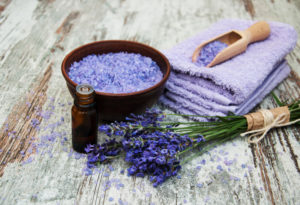To many people, “lavender lemonade” is the go-to drink recipe for a range of health problems, including everything from headaches to anxiety and sleep issues. Rather than popping a few pills, a lavender headache drink might be enough to provide the natural relief your body needs.
This recipe can clear away minor head pain in a matter of minutes. And while it likely won’t fully eliminate migraines, lavender essential oil on its own can provide serious natural pain relief.
Health Benefits of Lavender Essential Oil
Lavender oil possesses a host of natural wellness properties, including anti-fungal, anti-inflammatory, antiseptic, antibacterial, and anti-inflammatory. It is one of the most versatile oils, often referred to as the “starter oil,” and there are many lavender blends available used for a variety of reasons.
Three of the most common uses for lavender are anxiety, sleep, and general pain. It’s particularly effective for relieving headache pain. Traditionally, you could run the oil through a diffuser or apply it topically by massaging it on your temples and behind your ears.
Depending on the brand you use, lavender can also be taken internally. Just be sure to check the brand label to ensure the product is safe for internal use. Some essential oil brands aren’t 100 percent pure, and are not safe for consumption.
Flavoring your lemonade with lavender is an excellent way to take advantage of its incredible medicinal properties. It calms the senses. Relieves stress. And reduces many forms of discomfort.
[amazon box=”B005V22SEI”]
 Aromatherapy Research For General Wellness
Aromatherapy Research For General Wellness
There has been extensive research into lavender’s curative powers. For instance, Florida researchers discovered that lavender eased anxiety and reduced pulse rates in nursing students who were taking stressful exams. It has even been used in hospital settings (we know, shocking) to reduce pre-surgery distress.
According to a study by Wheeler Robins,
“Much research on lavender has focused on the administration of lavender via an olfactory route. The activity of lavender olfaction has been displayed in several clinical trials. The efficacy of lavender aromatherapy is thought to be due to the psychological effects of the fragrance combined with physiological effects of volatile oils in the limbic system. The calming benefits of lavender oil and single constituents may be the origin of the traditional use of lavender. Lavender oil olfaction has been shown to decrease anxiety, as measured by the Hamilton rating scale, and greatly increase mood scores.”
Other studies have shown that lavender:
- Was effective at treating patients in intensive care units who were suffering from anxiety.
- Offers pleasing fragrant benefits that correlate to positive changes in the autonomic nervous system.
- Improved the mood, alertness, and speed at which people can perform mathematical calculations.
- With or without massage, can reduce the need for traditional analgesics in children and adults.
- Reduced depressed mood and anxiety in female patients suffering from chronic hemodialysis.
And on and on…
[amazon box=”B07D7HPJF8″]
 Lavender Lemonade Recipe For Headaches & Anxiety
Lavender Lemonade Recipe For Headaches & Anxiety
So without further ado, below is the recipe for lavender lemonade.
This won’t take long. Lavender lemonade is a simple drink recipe you can craft in a matter of minutes. All you need is:
- Drink pitcher
- 12 cups of water
- 2 drops of food-grade lavender essential oil
- 6 lemons
- Raw honey (optional)
Directions:
- Peel and squeeze the lemon juices into the pitcher
- Add the water, lavender oil, and optional honey
- Stir all the ingredients together
- Chill in the refrigerator
[amazon box=”B007IECL2G”]
Additional Ways to Use Lavender for Pain & Stress
- Add four to five drops of lavender oil to a warm bath to moisturize your skin and promote relaxation.
- Diffuse ten to twelve drops in your bedroom at night to curb insomnia and promote restful sleep.
- Diffuse in your office to provide natural stress relief during your workday.
- Massage on your back and neck to reduce soreness, swelling, and general pain.

